
![]()
PHASE TWO OF 'BIG PIPE' UNDERWAY
Port Colborne
Regional council has green-lighted a report which outlines the first steps of phase two of the Wainfleet Lakeshore servicing project.
Three committees will now work with regional and township staff and report back to regional council within a 14-18 month period on how to fix the problem of groundwater contaminated with E. coli bacteria, according to the report.
Niagara Region staff began compiling a structure on how to carry out a number of studies on the project after it was endorsed in principle by the regional and township councils earlier this fall.
The committees will be involved with studies such as the design of the extension of sewer and water services from Port Colborne, the social impact of the proposed infrastructure and its cost evaluation.
THE THREE COMMITTEES ARE:
The Wainfleet servicing project joint advisory committee, which will be compromised of regional representatives from the planning and public works committee; the corporate services committee; and the public health and social services committee.
At regional council on Dec. 20, the decision was made to allow as many regional councilors who want to sit on the committee, after Niagara Falls Councilor. Bill Smeaton balked at limiting it to one regional councilor.
Smeaton, along with Niagara Falls councilors Barbara Greenwood and Norm Puttick, Fort Erie Councilor. Shirley Cordiner and Fort Erie Mayor Doug Martin, Grimsby Councilor. Debbie Zimmerman and St. Catharines Counilor. Tim Rigby signed up for the committee.
There will also be one representative from Wainfleet and one from Port Colborne, as well as the commissioners of the public works, corporate services and public health departments at the region. The region's director of water and wastewater services, a legal advisor from corporate services and a staff member from the public health department will complete the committee.
The joint advisory committee will provide input and advice into key project tasks and critical decisions in the Wainfleet servicing project, said the report.
The Wainfleet servicing project team, which will be comprised of regional and township staff. The local representative for the Ministry of the Environment will also participate at times. According to the report, the project team will provide technical input and complete tasks such as creating drafts for the request-for-proposal submissions and figuring out final cost estimates.
The public liaison committee, which will have four members from Wainfleet and four members from the Niagara Region outside of Wainfleet. Wainfleet residents will form a balanced view of comments and concerns of the project and will be chosen from solicited applications to township council, said the report.
Wainfleet Mayor Barbara Henderson said she is happy with the final structure of the committees and also with the level of participation from other regional councilors.
"We need to have the various committees so we can accomplish everything," she said. "I was anticipating three regional representatives but I was very pleased with the enthusiasm of the additional councilors."
Henderson anticipates people can begin applying to be on the public liaison committee after the first joint advisory committee meeting at the beginning of the new year.
Betty Konc, chair of the Wainfleet water and sewer committee, says she would like to apply to the public liaison committee and definitely thinks residents from the affected area need to have a say.
"I think we should sit on it because we at the Wainfleet water and sewer committee are the ones who created the big stink about this," she said.
She also questioned why the number of residents from outside of Wainfleet matches the number of township residents who will make up the committee.
"It's not going to affect them directly the way it's going to affect we who are on the lakeshore," she said.
As the separate committees begin meeting and completing tasks in the new year, Konc wonders how all of their work will revolve around the township's secondary plan for the lakeshore, which is supposed to be a model to curb huge jumps in development in the area. The region has said all along that it was up to Wainfleet to keep the lakeshore area rural, how the secondary plan will fit into the committees' work and the changes in township staff is anyone's guess, said Konc.
"That's something that hasn't been made clear," she said.
Not sexy, but critical Infrastructure such as sewers and roads isn't flashy.
But they're the nuts and bolts that keep society running smoothly
Ask most Niagara residents if they think they're paying too much in taxes and you'll almost invariably get an emphatic "yes."
But ask them if they're willing to put up with potholes the size of bathtubs on their roads, murky drinking water coming out of their taps or sewage backing up in to their basements during storms and you'll also get a major "no."
The problem is taxes and infrastructure are intricately linked. And with a growing number of studies in Niagara showing hundreds of millions of dollars more needs to be spent if our roads and water and sewer plants and pipes are to be kept from crumbling, local politicians are being faced with some tough decisions.
There is a growing body of evidence that unless substantially more is spent on infrastructure in Ontario, it will cost taxpayers far, far more in the long run. That's because as roads and water and sewer plants age, the cost to repair them climbs exponentially if they're allowed to deteriorate past a certain point.
But there is no bottomless pit of money. Years ago, senior levels of government would routinely subsidize major municipal water and sewer projects. There are still provincial-federal programs municipalities can apply to for funding, but to a large extent cities, regions and towns are on their own.
In Niagara, the dollar squeeze is especially keen. That's because statistics show this region has the lowest average household income of any region in Ontario. On top of that, Niagara has a sluggish growth rate compared to booming regions such as Peel, meaning there simply aren't as many new taxpayers to share the cost of projects.
Niagara Falls city councilor Janice Wing said she believes Niagara is headed for a crisis.
During the recent municipal election, Wing wrote on her website that she's had pensioners and other people on low income calling her to ask how they'll be able to remain in their homes given continually escalating costs for heating and hydro on top of increases in property taxes and sewer and water bills.
She said it's time for local governments to get back to the "nuts and bolts," things like roads and water and sewer infrastructure, instead of pursuing such things as new arenas, community centers or parking garages, to avoid crushing tax burdens in the future.
But local politicians will tell you no-one wants to go to a ribbon cutting for a new sewer main.
Niagara's regional government, which operates six water treatment plants and 11 sewage treatment plants, along with hundreds of kilometres of underground pipes, will spend more than $90 million on its water and sewer infrastructure by the end of 2007. But Leo Gohier, an expert hired as a consultant by the region, told regional politicians last summer that the region needs to increase spending on water treatment operations by 86 per cent and on sewage treatment operations by 75 per cent if it is to keep those systems in running order.
Many of the sewage plants, for instance, are inching toward a century old. As those plants get that old, costs for emergency repairs soar, Gohier said.
The problem, he said, is residents' lack of willingness to pay more for something that's largely hidden under ground. People generally ignore infrastructure until it fails.
The region isn't alone in its situation: many of Niagara's towns and cities also have aging infrastructure that will need major cash to fix. The Town of Fort Erie was told by a consultant recently that it needs to spend more than $10 million over the next decade -- this, in a town of just less than 30,000 people -- just to replace 18 kilometres of the town's 70 kilometres of cast iron water mains. The consultant said the town's water mains have exceeded their 75-year lifespan, meaning they're vulnerable to frequent bursting.
Some areas of other Niagara cities have underground pipes a century old.
City of Thorold politicians found out in the summer that they need to spend $4 million more on the city's aging system of water mains. A report found more and more money is being wasted to pay for water flows lost to leaks: water loss has increased to 27 per cent, up from 22 per cent in 2004 and 16 per cent before that.
The Ontario Sewer and Watermain Construction Association said water loss across the province is costing taxpayers $160 million a year. In a report in September, the association blamed "short-term political decision-making" at the local level as a key reason for deteriorating systems.
Some cities are in a similar situation with their roads. In Niagara Falls, a recent study found the city needs to somehow come up with $23 million to rebuild streets that have deteriorated past the point of rehabilitation. That's $6.3 million more than what the city was told three years ago it needed to spend, causing some city councilors to wonder how they'll pay for it.
"We all know we need to put more money into roads," Councilor. Vince Kerrio said at the time. "But there is only so much money."
The city also found out it needs to spend $88.4 million to bring its sewer and water systems up to par, including $29 million in immediate work that needs to be done.
City Councilor. Carolynn Ioannoni said that's "88.4 million un-sexy" reasons to invest in infrastructure instead of more visible projects such as new arenas.
MORE INVESTIGATION OF PIPE ALTERNATIVES WAS REQUIRED
Residents of Wainfleet received another message from our mayor today in the form of a flyer called "Update ... staying in touch." I would like to take this opportunity to correct some of the impressions in this update.
Namely the first asterisk on the flyer. The mayor states "the region respected our campaign promises by initiating a further investigation of alternatives." The initiative the region undertook last April was a fulfillment of one of the five conditions set out by the minister of the environment of our EA., plain and simple, not as a boon to campaign promises made by our councilors.
Secondly at this "workshop" to look into alternatives last April, the region cast in the role of panelists, the same consultants and experts, with a few new faces thrown in, who took part in the value analysis exercise in 2005 and basically told the region what they wanted to hear, that the baseline recommendations of the EA. are the appropriate solutions.
One would think if they truly did want to explore the onsite industry alternatives, perhaps members from the Ontario On-site Wastewater Association would have been on the panel, as well as some of the folks that actually own these companies and have the answers at their fingertips.
But no, that didn't happen. Did any of the consultants and experts that were on the panel call these companies and ask any probing questions about the systems that are out there and how they deal with other areas of the province that have similar problems?
The answer is no they didn't, I know this because I have been in contact with most of these companies on an ongoing basis since last March, when I attended their conference.
So if they didn't contact these companies to get direct information and only ask a very few questions of the two companies that were allowed to do a presentation for the panel (at the last minute I might add, and had I not stirred the pot to get them on the agenda the panel would not have heard from the onsite industry at all) then how did they come to the same conclusion as in 2005.
I fail to understand how the mayor and our council could believe all due diligence was taken by the region when it was patently apparent to those of us that attended that it was yet again just another exercise they can point to and say we did what we were asked to do and we came to the same conclusions. Too bad they didn't put a little more effort into it, they may just have come up with totally different conclusions.
Next I would like to address the report brought forward to regional council Thursday night. They are proposing a public liaison committee be put together and be made up of regional councilors and some Wainfleet residents as well as some residents from elsewhere in the region. I was on the original public advisory committee, which was put in place due to a presentation I made to the regional council in 2004.
I firmly believe if anyone should sit on this committee it is myself, and if not me than one of my own committee members. My Wainfleet water/sewer committee has been actively opposing this project since August 2004. Now that we are close to being an incorporated entity and a ratepayers association it should be obvious that members of this committee be part of the new PLC.
Over the past three years my committee has been the conduit for information along the lakeshore, so it makes sense that with that amount of trust displayed by the lakeshore residents that I be one of the four chosen to sit on this new PLC.
We have always proposed that both the local council and the regional council work with our committee and the lakeshore residents, perhaps with this new PLC we can finally achieve this goal, and work together rather than in opposition.
Betty Konc
Wainfleet
WHAT IS A SMALL DEVELOPMENT IN WAINFLEET?
An open letter to Mayor Henderson and her town council:
In your review of your first year in office you make mention that development in Wainfleet will be moderate with no large subdivisions.
I would like to know what you do consider to be a large subdivision because in the same paragraph you mention the development project at the former Lakewood Camp site.
That development will include 35 homes in Phase 1 and additional phases to follow ending up with 60-plus (possibly the original 81) homes on 20 hectares of property.
If that is what you consider to be "moderate" and if you consider that keeping with the "small rural atmosphere" that the people of Wainfleet want, you are sadly mistaken.
And as far as an area for the Fowler Toads, do you really expect those toads to survive with that many people around?
The only thing you did admit to is that the Lakewood proposal will satisfy a raised tax base.
But as far as helping everyone in Wainfleet with road maintenance and infrastructure - your infrastructure is implementing the water and sewer system at the lakeshore. This is how you expect to pay for your system.
Once again, you have only confirmed what those of us on the Lakeshore and throughout Wainfleet have said all along - you have your own agenda and it does not include the wants and needs of the people of Wainfleet.
Lee Bott
Wainfleet
INFRASTRUCTURE IN GOOD SHAPE
There is danger looming if funding is not granted to municipalities to fix infrastructure, Councilor. Kate Leigh told council Monday.
The city councilor sits on the Federation of Canadian Municipalities board of directors and updated council on a presentation made last month. The municipal infrastructure survey shows a $123 billion deficit of deferred infrastructure work across the country.
"Over the past 25 years municipal infrastructure fell," Leigh told fellow councilors during a delegation she made on behalf of FCM. "We see it as a council every year during budget."
Municipalities are responsible for 50 per cent of Canadian infrastructure, she said, and the struggle municipalities have to maintain their systems has led to years of deferred infrastructure work.
Following Leigh's presentation mayor Vance Badawey instructed director of operations Sal Iannello to prepare some numbers for Port Colborne. The city's water infrastructure is estimated to be worth $45.5 million and wastewater at $42.5 million. Based on a 75-year replacement plan Iannello said the city should be spending about $610,000 a year. Because of a backlog of deferred work, he said initially the city would need to invest $2.9 million the first year and $1.2 million a year after that for water. Wastewater would need to be increased to $750,000 a year.
Currently the city sets aside about $500,000 for water and $250,000 for wastewater.
"In all reality, Port Colborne is on the better side compared to the rest of the region," said Badawey.
ALTERNATIVES TO BIG PIPE EXIST
Once again let's address the water and sewers issue in Wainfleet.
In the column by Queen's Park bureau chief James Wallace, headlined Infrastructure deficit growing, the Tribune, Monday, Nov. 26, the writer says Ontario's minister for infrastructure renewal, David Caplan, estimates that in Ontario alone there is a $100 billion infrastructure deficit. The column notes that taxpayers will certainly have to pay more and we as Ontarians already pay the highest property tax bills in the country.
With all that being said, I still cannot fathom why the powers that be want to install water and sewers line from Lakeshore Road in Wainfleet to Port Colborne at a $75 million cost to taxpayers, likely more.
And yes it will cost all Niagara taxpayers this unnecessary cost. We are told the ground water is affected with e-coli and not fit to drink.
Who along the lakeshore and really anywhere in southern Ontario drinks from well water without proper purification?
Niagara Medical Officer of Health Dr. Robin Williams chose to implement a water boil advisory along the lakeshore in Wainfleet because of the presence of e-coli bacteria found in the ground water, brought on mainly by human waste filtering into our ground water brought on by failing septic systems.
We do have alternatives. When we first built here in Wainfleet we had no services, so we installed an approved septic system (priced at approximately $15,000) and purchased a state of the art water purification system (approximately $3,500).
We collect mostly rain water and at times rely on our local water providers for the balance of our water needs. We have our water tested by the regional heath department on a regular basis and have always had a clean report - water that we can drink from the tap, pure water, water with no sign of any contamination.
Now this was all done at our cost and none to the taxpayer. We have a safe septic and water system.
So what is the problem?
Since Ontario has a $100 billion infrastructure deficit, David Caplan, regional council and Wainfleet town council should not add to it.
Just leave us alone to fix, replace and repair, we will save the taxpayers a minimum of $75 million.
Why spend $75 million? So we can attach to Port Colborne's already antiquated and failing infrastructure?
We can eliminate the need for all of this unnecessary expense simply by reducing sewage spin-off, by replacing antiquated septic systems. Numerous water purification systems are available through many manufacturers. These problems and solutions have been addressed many times before, I know, but frustration has a tendency to repeat.
If our elected council chooses to hook up with Port Colborne rather than the other solutions, well then I'm sorry I voted for our elected council and I look forward to the next election when I can vote them all out.
Adrian Goemans
Wainfleet
Wainfleet OMB hearing adjourned until March 25
WAINFLEET The Ontario Municipal Board hearing regarding the proposed Reeb Quarry has been postponed until next March.
Deliberations were adjourned June 29 to allow for additional studies by hydrogeologists hired by the township, the region and the Niagara Peninsula Conservation Authority to conduct a peer review of information provided by the applicant, MAQ Aggregate.
The hearing resumed for one day on Nov. 20, but was once again postponed until March 25 to give the township’s hydrogeologists time to analyze information provided.
“We were not in a position to go ahead,” said Sara Premi a lawyer with Sullivan Mahoney, the law firm representing the township during the hearings.
There have been a number of issues discussed back and fourth between MAQ’s hydrogeologists and those against the proposed quarry. At one point, MAQ proposed to pipe water from the Quarry, down Quarry Road through an underground pipe into Lake Erie - an idea that was rejected by council.
The proposal currently being examined is an onsite water retention pond which wold gradually discharge the quarry’s water into the Eagle Marsh drain.
The hearing was initiated when John Allan Reeb appealed to the OMB after Wainfleet council refused to enact a proposed amendment to the official plan to designate land on the south side of Highway 3 to permit a limestone quarry and associated uses.
Lawyer Tom Richardson said the township “is still against the quarry for a number of reasons including planning, traffic and hydrogeology.”
MAYORS' BREAKFAST LOOKS AHEAD
PORT COLBORNE MAYOR VANCE BADAWEY FOCUSED ON DEVELOPMENT AND WAINFLEET MAYOR BARB HENDERSON ADDRESSED REORGANIZATION AT THE FINAL 2007 MAYORS' QUARTERLY BREAKFAST HELD THURSDAY AT ON THE WATERFRONT RESTAURANT.
"THE NEW COMMUNITY MULTI-USE CENTRE HAS PROCEEDED WITH A COMMUNITY COMMITTEE ENSURING ALL INTERESTS ARE BEING MET WITHIN THE INVESTIGATING STAGE," BADAWEY SAID. "COUNCIL HAS MOST RECENTLY MOVED FORWARD ON THE COMMITTEE'S RECOMMENDATION TO PROCEED WITH AN EXPRESSION OF INTEREST PROCESS THAT WILL RECOGNIZE POTENTIAL PARTNERS RESULTING IN BOTH SECURING A POTENTIAL PARTNER WITHIN THE BASE PLAN, AS WELL AS, POTENTIAL ADDITIONAL INVESTMENT OPPORTUNITIES."
HOW NICKEL BEACH FITS INTO EAST SIDE DEVELOPMENT WAS ALSO DISCUSSED BY PORT'S MAYOR.
"AS AN ADDITIONAL THRUST ATTACHED TO THE BEACH, COUNCIL IS MOVING FORWARD WITH A BROWNFIELD COMMUNITY IMPROVEMENT PLAN, LOOKING AT NEW CITYWIDE GROWTH OPPORTUNITIES ON BROWN FIELD SITES, INCLUDING THAT OF THE WATERFRONT ADJACENT TO THE BEACH. AS WE WORK TOWARD PLANNING FOR ADDITIONAL OPPORTUNITIES ALONG THE WATERFRONT, IT WILL BE CRITICAL THAT NICKEL BEACH BE RECOGNIZED AS AN EXISTING ASSET THAT WILL CONTRIBUTE TO THE OVERALL DEVELOPMENT OF THE WATERFRONT, THEREFORE, ANY IMMEDIATE INVESTMENT MAY BE PREMATURE UNTIL THE OVERALL CIP IS COMPLETED."
PLANS TO CREATE A WELCOME CENTRE AT HUMBERSTONE HALL WERE ALSO INCLUDED IN BADAWEY'S COMMENTS AS WELL AS THE NEED TO WORK WITH THE DOWNTOWN BIA AND THE GATEWAY ASSOCIATION IN THE NEW YEAR.
BADAWEY INVITED CITIZENS TO SIT ON TWO ECONOMIC DEVELOPMENT ADVISORY COMMITTEES, ONE DEALING WITH TOURISM AND RECREATION AND THE OTHER DEALING WITH INDUSTRIAL, COMMERCIAL AND INSTITUTIONAL OPPORTUNITIES. "STREAMLINING ECONOMIC DEVELOPMENT INITIATIVES CONTINUES TO BE A DESIRE OF BOTH COUNCIL AND STAFF. HOWEVER, IT IS EXTREMELY IMPORTANT THAT WE CONTINUE TO HEAR FROM MEMBERS OF OUR COMMUNITY THAT BRING A GREAT DEAL TO THE TABLE IN RELATION TO MOVING FORWARD BOTH ECONOMIC RETAINMENT AND GROWTH."
ROSELAWN CENTRE, SUGARLOAF HARBOUR MARINA AND PHYSICIAN RECRUITMENT ALSO TOPPED THE LIST OF ISSUES BROUGHT FORWARD BY BADAWEY.
"IT HAS BEEN NO SECRET THAT IT IS COUNCIL'S DESIRE TO MAXIMIZE OUR MARINA OPERATIONS AT SUGARLOAF. COUNCIL HAS INSTRUCTED STAFF TO CONTINUE TO LOOK AT NEW WAYS OF DOING BUSINESS IN AN ENVIRONMENT THAT OFFERS MORE RETURN TO THE INVESTOR - THE CITY AND THE TAXPAYER. AS WELL, STAFF HAS BEEN INSTRUCTED TO BEGIN DISCUSSIONS WITH MARLON MARINA AS THEIR LEASE EXPIRES IN 2010.
HENDERSON DISCUSSED "NEW FACES" AT TOWN HALL AS THE ONGOING ORGANIZATIONAL REVIEW MOVES FORWARD.
SHE SAID TWO NEW FACES ON STAFF ARE FORMER PORT COLBORNE PLANNER CHUCK MILLER AND WAINFLEET LIBRARY CHIEF EXECUTIVE OFFICER TARA MENDEZ.
"IN ADDITION TO THESE NEW EMPLOYEES, THE TOWNSHIP IS IN THE MIDST OF RECRUITING A CHIEF ADMINISTRATIVE OFFICER, A TREASURER, A DIRECTOR OF OPERATIONS AND A MANAGER OF OPERATIONS.
IT'S ANTICIPATED THAT INTERNAL CANDIDATES WILL FILL THE CAO POSITION AND THE POSITION OF MANAGER OF OPERATIONS," SHE SAID.
HENDERSON ALSO INVITED PEOPLE TO ATTEND HER NEW YEAR'S LEVEE ON SATURDAY, JAN. 5 FROM NOON TO 3 P.M. IN WAINFLEET COUNCIL CHAMBERS. SHE THEN ANNOUNCED THE WINNERS OF COUNCIL'S ANNUAL CHRISTMAS CARD CONTEST. WINNING ENTRANTS WERE JESSICA FLAGG AND ALEX HOTSON, TWO STUDENTS FROM WINGER SCHOOL. THEIR ARTWORK WILL NOW BE FEATURED ON THIS YEAR'S TOWNSHIP GREETING CARD. THE STUDENTS WILL RECEIVE A FRAMED ENLARGEMENT OF THEIR WINNING DESIGN ON DEC. 11.
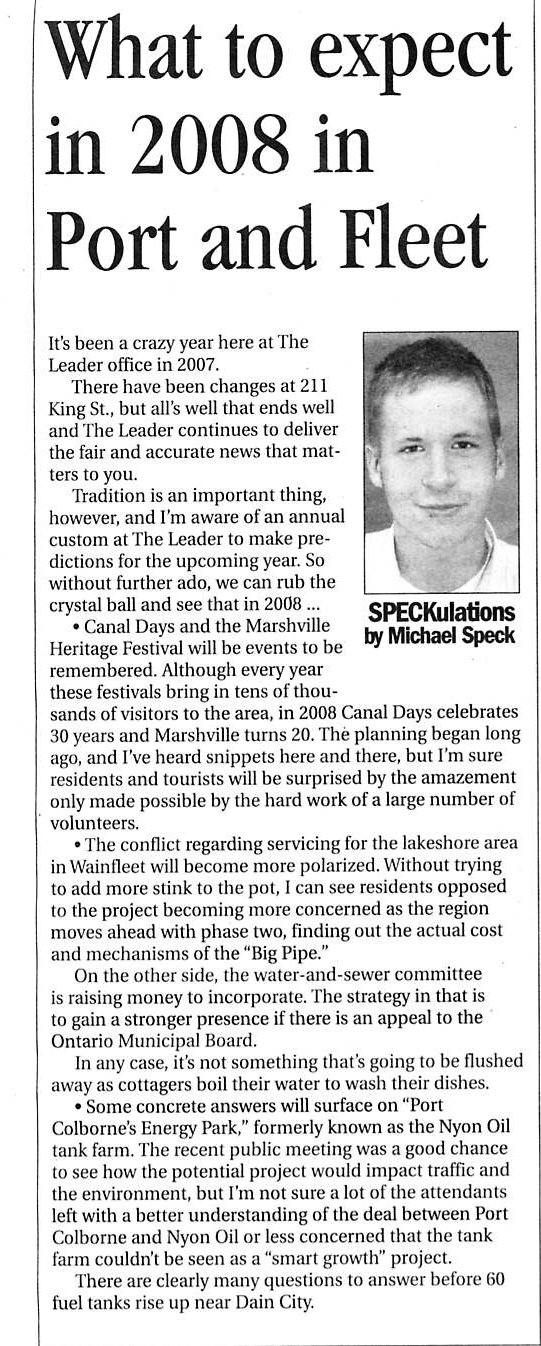

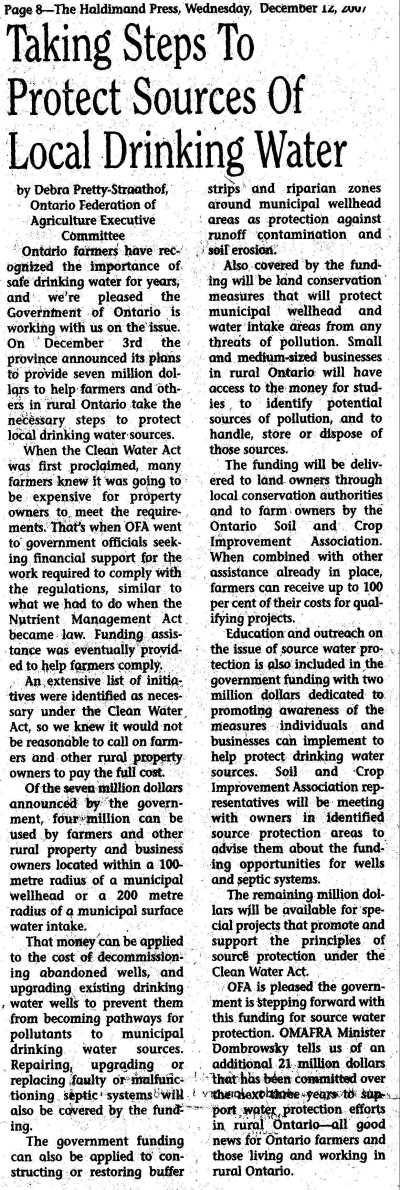
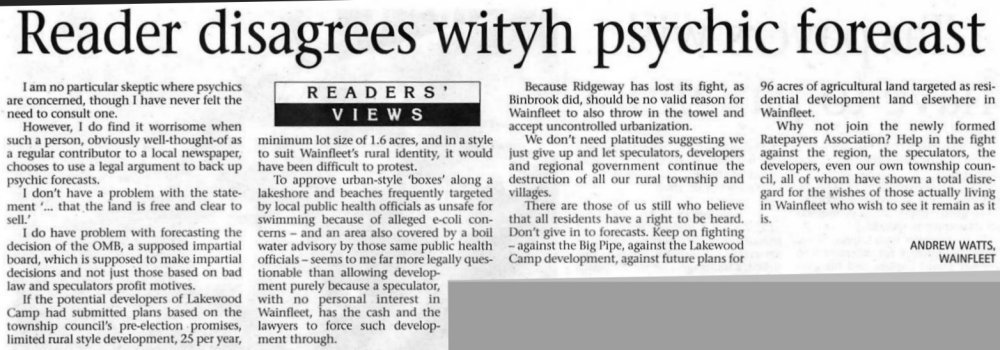
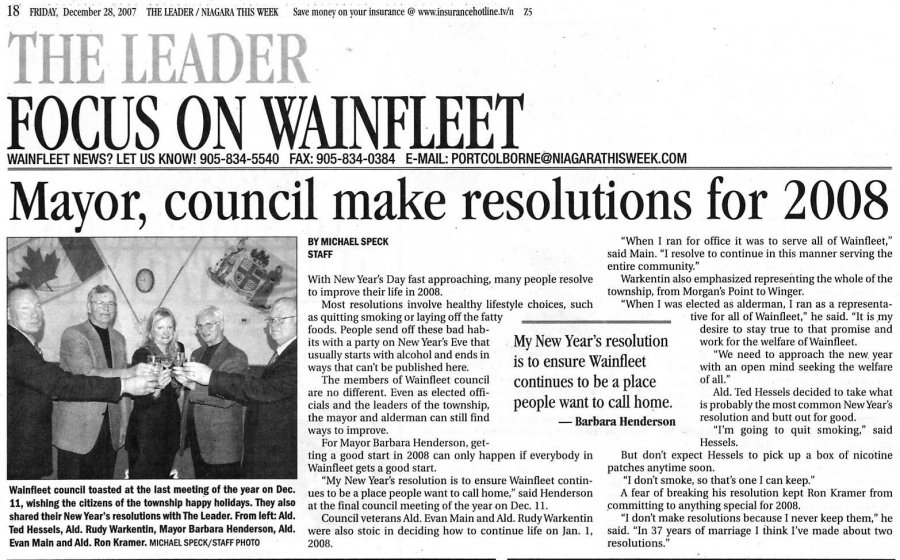
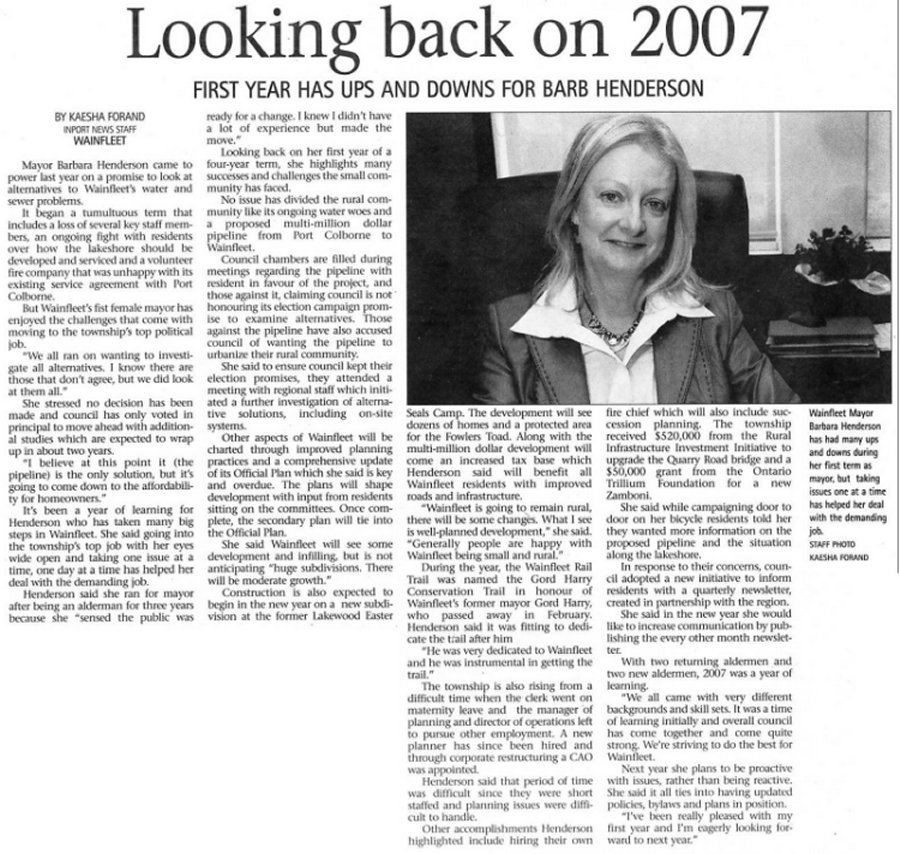
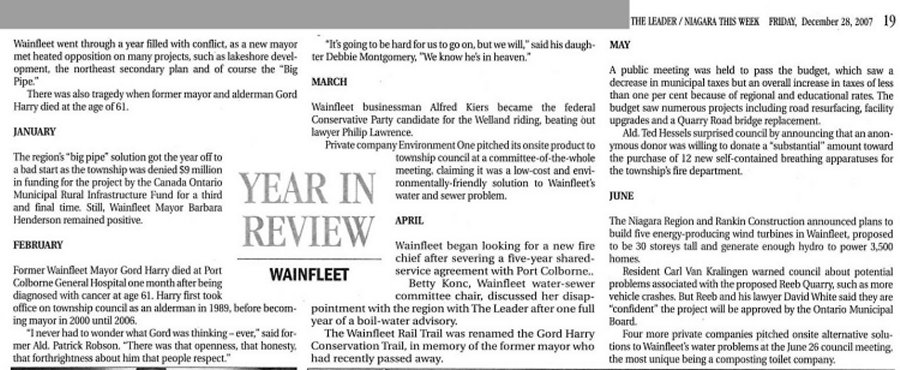
They are listening and know we aren't going away!
Here's hoping for some changes to the problems .

